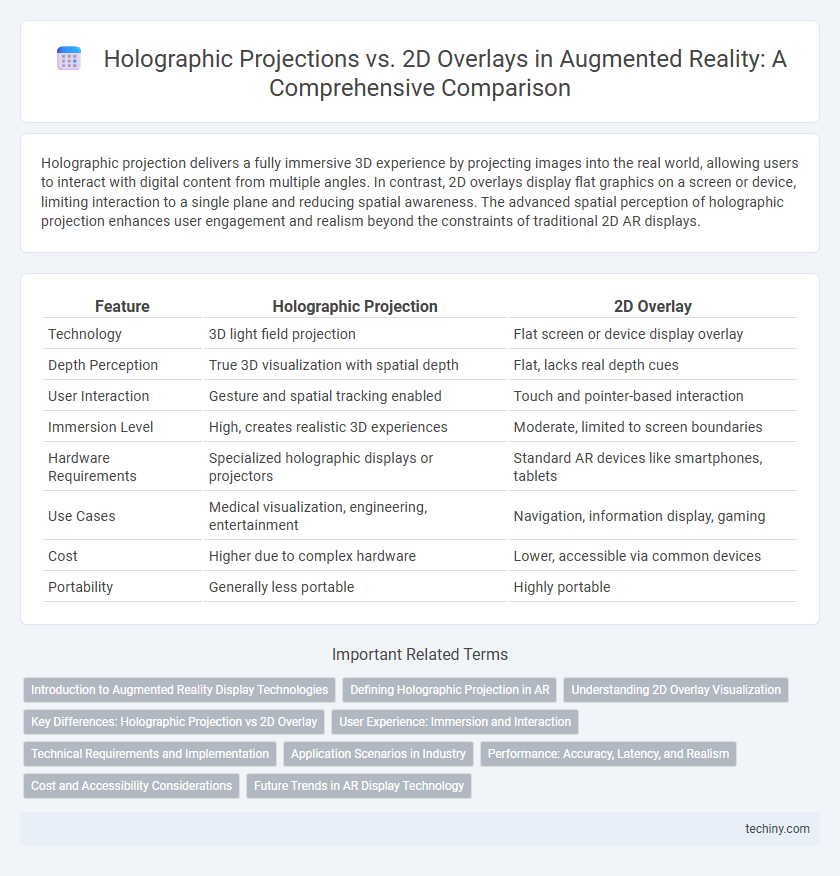Holographic projection delivers a fully immersive 3D experience by projecting images into the real world, allowing users to interact with digital content from multiple angles. In contrast, 2D overlays display flat graphics on a screen or device, limiting interaction to a single plane and reducing spatial awareness. The advanced spatial perception of holographic projection enhances user engagement and realism beyond the constraints of traditional 2D AR displays.
Table of Comparison
| Feature | Holographic Projection | 2D Overlay |
|---|---|---|
| Technology | 3D light field projection | Flat screen or device display overlay |
| Depth Perception | True 3D visualization with spatial depth | Flat, lacks real depth cues |
| User Interaction | Gesture and spatial tracking enabled | Touch and pointer-based interaction |
| Immersion Level | High, creates realistic 3D experiences | Moderate, limited to screen boundaries |
| Hardware Requirements | Specialized holographic displays or projectors | Standard AR devices like smartphones, tablets |
| Use Cases | Medical visualization, engineering, entertainment | Navigation, information display, gaming |
| Cost | Higher due to complex hardware | Lower, accessible via common devices |
| Portability | Generally less portable | Highly portable |
Introduction to Augmented Reality Display Technologies
Holographic projection in augmented reality creates three-dimensional images projected into the environment, offering immersive, spatially accurate visuals without requiring a screen. In contrast, 2D overlay displays place flat graphics or information onto a user's view via screens or glasses, limiting depth perception and spatial interaction. Understanding these display technologies is crucial for advancing AR applications across fields such as medical imaging, industrial design, and gaming.
Defining Holographic Projection in AR
Holographic projection in augmented reality (AR) creates three-dimensional, lifelike images that appear to occupy physical space, enhancing user immersion and interaction. Unlike 2D overlays that display flat graphics on screens, holographic projections enable realistic depth perception and spatial awareness by projecting light fields or using volumetric displays. This technology significantly improves AR applications in fields such as medical visualization, remote collaboration, and industrial design by providing intuitive and context-rich experiences.
Understanding 2D Overlay Visualization
2D overlay visualization in augmented reality involves superimposing flat images or text onto a user's real-world view, enhancing information access without altering depth perception. This method relies on screen space positioning, which simplifies interaction and reduces processing demand compared to holographic projections that create three-dimensional virtual objects. By prioritizing clarity and information density on a flat plane, 2D overlays effectively support applications like heads-up displays and navigation aids where immediate, unobtrusive data presentation is critical.
Key Differences: Holographic Projection vs 2D Overlay
Holographic projection creates three-dimensional images that appear to occupy real space, enhancing spatial interaction and depth perception, while 2D overlays display flat graphics directly on user screens without depth cues. The key difference lies in immersion; holographic projections provide a more lifelike experience by blending virtual objects seamlessly into the physical environment, whereas 2D overlays remain screen-bound and less interactive. This spatial realism makes holographic projection ideal for applications in medical visualization and complex design, whereas 2D overlays suit simpler information displays and heads-up interfaces.
User Experience: Immersion and Interaction
Holographic projection enhances user experience by creating fully immersive 3D environments that enable natural interaction through spatial gestures and eye tracking, offering a more intuitive and engaging AR experience. In contrast, 2D overlays provide limited depth perception and interaction capabilities, often confining users to flat, screen-based interactions that reduce immersion. The spatial presence and multimodal interaction in holographic projection significantly improve user engagement and task effectiveness in augmented reality applications.
Technical Requirements and Implementation
Holographic projection in augmented reality requires advanced spatial mapping, high-resolution depth sensors, and powerful GPUs to render true 3D images that interact with real-world environments. In contrast, 2D overlay relies on simpler camera tracking and basic image processing, allowing for easier implementation on mobile devices with standard displays. Implementing holographic projections demands precise calibration and dedicated hardware like laser projectors or transparent waveguides, which significantly increase complexity and cost compared to 2D overlays that use conventional screens.
Application Scenarios in Industry
Holographic projection in augmented reality enables immersive 3D visualization for industrial applications such as assembly line troubleshooting, where spatial awareness improves precision and reduces errors. In contrast, 2D overlay AR is commonly used for equipment maintenance, providing technicians with heads-up displays of schematics and step-by-step instructions directly on machine surfaces. Automotive manufacturing and aerospace industries benefit from holographic projections for prototyping and complex spatial training, while 2D overlays streamline routine inspections and quality control processes.
Performance: Accuracy, Latency, and Realism
Holographic projection in augmented reality offers superior accuracy and realism by projecting 3D images that integrate seamlessly with the real environment, reducing latency through advanced spatial mapping and sensor fusion. In contrast, 2D overlays often suffer from limited depth perception and alignment errors, resulting in lower accuracy and a less immersive experience. The enhanced processing capabilities of holographic systems minimize latency, ensuring smoother interactions and more precise real-time responses compared to traditional 2D overlay methods.
Cost and Accessibility Considerations
Holographic projection demands significantly higher costs due to advanced hardware requirements and complex calibration, limiting accessibility to specialized industries or high-budget projects. In contrast, 2D overlay technology leverages existing screen devices, offering an affordable and widely accessible option for mass-market applications. The scalable nature of 2D overlays enables rapid deployment across consumer devices without extensive infrastructure investment.
Future Trends in AR Display Technology
Holographic projection in AR enables realistic 3D visuals that interact seamlessly with the physical environment, offering depth perception and spatial awareness superior to traditional 2D overlays. Future trends highlight advancements in light-field displays and adaptive optics that enhance holographic clarity and reduce latency, driving immersive experiences beyond flat screens. Integration of AI-driven spatial mapping and ultra-high-resolution waveguides promises to revolutionize AR displays by delivering dynamic, context-aware holograms tailored for diverse applications in gaming, healthcare, and industrial design.
Holographic Projection vs 2D Overlay Infographic

 techiny.com
techiny.com